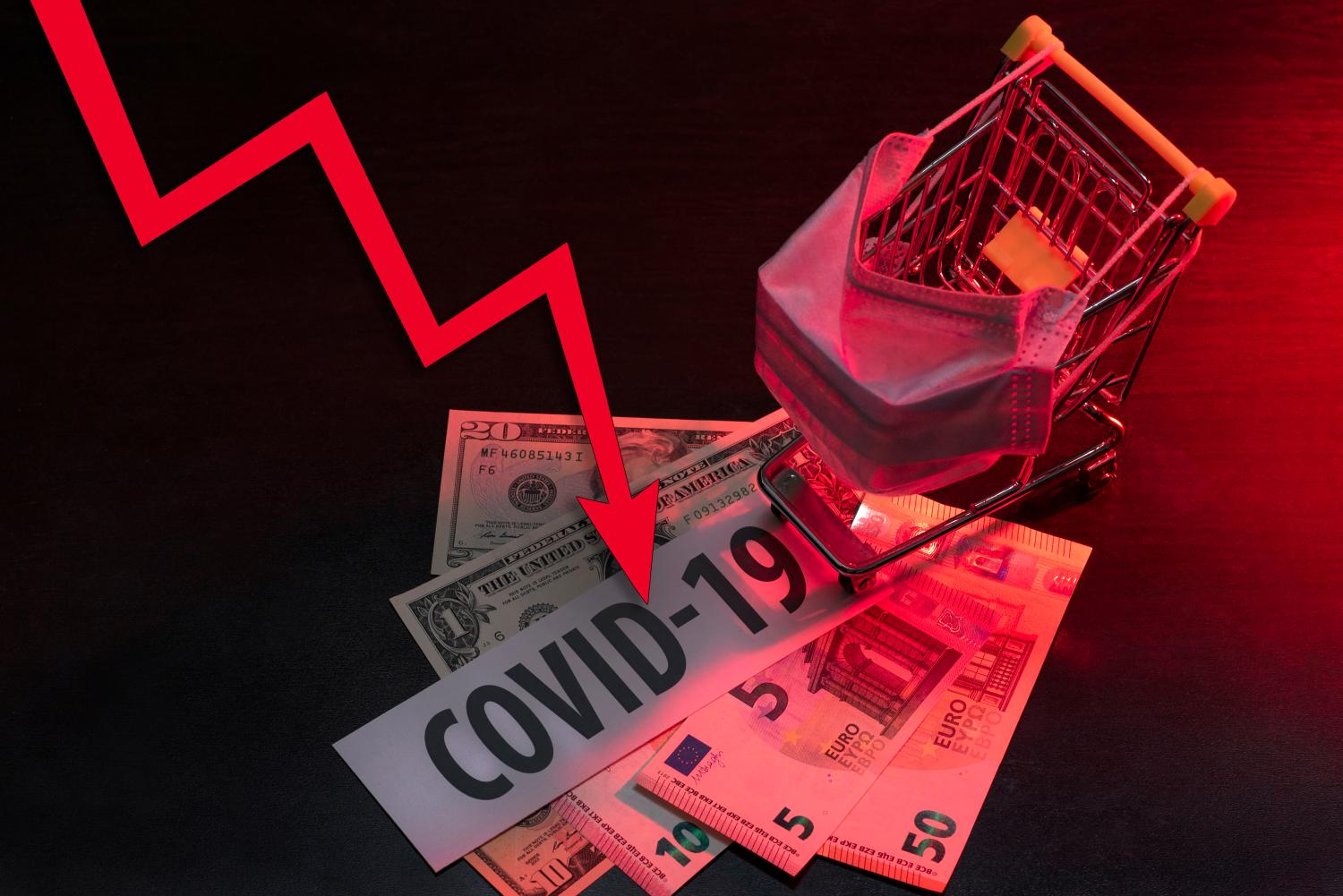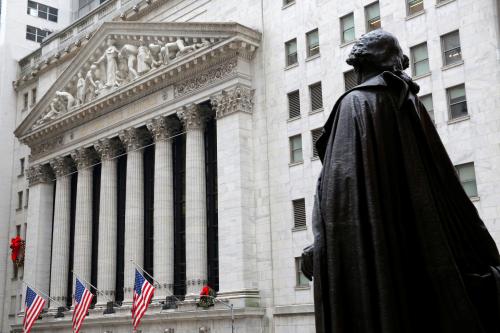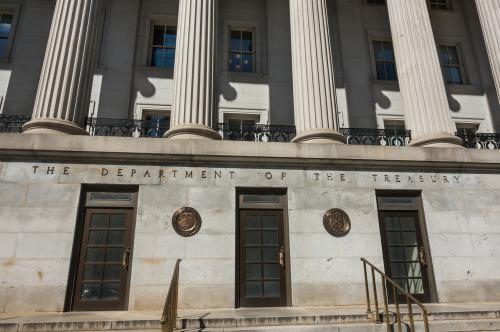This is a lightly edited version of remarks Don Kohn delivered at a Hutchins Center event on May 27, “COVID-19 and the financial system: How resilient are the banks? How are they supporting the economy?” A video and transcript of the event are available here.
The COVID-19 crisis could be a very severe stress event for the nation’s bank, one even more so than the severe scenario in the Federal Reserve’s recent stress tests. At least, there’s a pretty fat tail out there, and the banks need to be resilient to that fat tail. They need to have enough resources to continue lending, to keep credit flowing, to reduce the scarring—a lot of which will happen anyway, but even more of it will if the banks don’t continue to lend. I think conserving that bank capital, building the capital, is key.
I want to make two points.
One, is there a regime built around the dynamic resilience? Yes, there is in the U.K., and I’ve been part of it as a member of the Financial Policy Committee. I also think that the U.S. capital regime was moving in the wrong direction before this stress event. Capital requirements from the stress test had fallen. The framework was becoming less countercyclical, and I’ll explain why I think that, and have a recommendation for it.
So, what have we been doing in the U.K.? For 5 years or so, we had a countercyclical counter buffer (CCyB) that was set at one percentage point in a standard risk environment. Last year we decided we wanted to make it two percentage points in a standard risk environment. We did it in part by looking, as Michael Blank, Samuel Hanson, Jeremy Stein, and Adi Sunderam do in their working paper, at the global financial crisis, and we could see that the buildup of capital before that crisis to make banks resilient would have had to be much larger than one or two percentage points. We questioned whether, if we had started from one, we could have gotten the CCyB up to the three and a half to five that the staff estimated we would have needed. We might have trouble even starting from two, say, in 2003 or 2004, but at least we would have a better chance of getting it to where it needed to be to make the banking system resilient. Going from one to two in a steady state would add a little bit to tier one capital requirements—about a quarter of a percentage point. It wasn’t a big increase, but a little increase in the quantity and quality of capital.
Our stress test helps the Financial Policy Committee decide on what the CCyB should be. As in the U.S., we make the test countercyclical. So the lower the unemployment rate is, the bigger the increase in the unemployment rate. The higher the property prices, the greater the fall in property prices are. We also look at the stress environment or the financial environment, the risk environment globally; in the past couple of years, our stress test has produced larger drawdowns in U.K. capital, importantly because of our perception of rising global risk, including leverage in U.S. businesses and leverages in China. We also believe releasing the CCyB can be an effective macroprudential tool to enable and encourage banks to lend once stresses materialize. I think the important point is it adds to the amount of capital that can be drawn down before banks get to a spot in the capital stack in which they might be required to cut back on dividends or share buybacks or bonuses paid to top management. So, it gives a bit of a cushion that banks should be willing to use.
So, we have released the CCyB twice, once in the market volatility to follow the Brexit referendum in June of 2016, and again just a couple of months ago in the COVID-19 stress. I think an important point is, we started from a standard risk environment with the buffer on the way to one in 2016 and on the way to two in 2020. It wasn’t the financial system that caused the stress, it came from somewhere else, but releasing the buffer gave the banks a way of lending so the banks wouldn’t be amplifying the stress.
With respect to the dividend issue, in 2016 we said that the banks could not use the released capital to increase their dividends. Of course, in 2020, the Bank of England, with the strong support of the financial policy committee has convinced the banks that they shouldn’t pay any dividends at all to conserve capital and should cut way back on cash bonuses to management.
“Building buffers on top of the basic requirements gets capital high enough so that in a stress event they will survive…The taxpayers are not required to step in.”
In addition, we have emphasized that buffers are usable, including the capital conservation buffer. Buffers serve two purposes. Building buffers on top of the basic requirements gets capital high enough so that in a stress event they will survive, which is especially important for systemically important institutions. The taxpayers are not required to step in. The second point is the one I’ve been emphasizing, that buffers give capital that can be drawn down in a stress to keep lending flowing and prevent banks from amplifying an already bad event. I think we’re in the middle of a test of that second rationale. Will the banks actually lend using the buffers, the management buffers they built up, the extra that they’ve gotten from the CCyB? How will markets view declines in capital and liquidity metrics, and will banks be willing to test how markets might view that? We’ve already restricted dividends and buybacks in the UK, so the threat of getting into the distribution restriction territory is much less, but still, it’s not clear how banks are going to deal with this. We hope and we will encourage them to recognize the externality in their lending. It’s in everyone’s collective interest that they all continue to loan and use the capital that they’ve built up because that makes the economy stronger, which in turn will reduce their losses.
The U.S., in contrast to the U.K., has been going in the wrong direction with its capital structure. The U.S. stress test is said to be the marginal capital constraint for many large banks. In updating a paper that Nellie Liang and I wrote, we showed that in 2019, the stress capital buffer, the capital buffer that fell out of the stress test, fell, and fell substantially. This result occurred in a situation in which the unemployment rate was falling. So, you would think the stress would be greater; the capital would be higher. Business leverage was rising. The risk environment was getting worse. Yet the required capital went down.
I think the Stein et al. paper for this webinar showed very, very clearly the starting point for capital in the stress is critical. The increases we’ve had in capital and liquidity from the regulatory reforms after 2009 have meant that the banks have been able to play a constructive role in 2020. It’s concerning that the 2019 stress test implied that the authorities were okay with that starting point declining, and particularly at a time when the banks were already talking about drawing down their management buffers.
And not only was there downward pressure on the starting place, but the changes in the stress test regime have weakened the countercyclical aspects of the stress test. Much of the countercyclicality that was in the stress test came from the requirement that banks in stress had to prefund eight quarters of dividends and share repurchases. Naturally, planned dividends and share repurchase rise in good times and fall in bad times. So, the prefunding requirement gave a bit of a higher capital stress requirement in good times and scaled it back in bad times. But that prefunding requirement has been scaled back to four quarters of dividends from eight or nine quarters of dividends and share buybacks. That’s much less countercyclical capital requirement from the stress tests.
A second point that’s been changed in the stress test is the Fed used to impose a soft limit of 30 percent of dividends as a proportion of distributions. They’ve eliminated that limit and allowed dividends to rise relative to share buybacks. We have seen graphically illustrated in the current environment, that it’s much easier to cut share repurchases than to cut dividends. Encouraging or allowing dividends to rise relative to share repurchases goes against the countercyclicality of the macroprudential requirement.
Finally, the test now assumes a constant balance sheet, rather than the small increase that it had assumed before for bank lending and risk related assets. I think it’s important that banks be able to fund and capitalize against increases in lending, even in a stress environment. Now, that requirement has been reduced.
“Fed and the other U.S. authorities [should] use the current experience to…reevaluate the public interest and costs and benefits of the way they were moving with the stress tests.”
So, my recommendation is that the Fed and the other U.S. authorities use the current experience to think very hard, to reevaluate the public interest and costs and benefits of the way they were moving with the stress tests, and the effect it was likely to have making bank capital more rather than less countercyclical. Moreover, I think the U.S. should adopt the framework of dynamic resilience with a positive countercyclical buffer in standard risk environments. As we’ve seen, stresses don’t always originate in the financial sector. So, waiting until the financial sector gives you a signal for raising the countercyclical buffer is too late. Things happen that mean that the public interest is served by releasing that buffer. This is the dynamic resilience that Jeremy and others were talking about. Release the capital buffer in a stress in order to give banks more incentive to keep lending. For the starting point in the standard risk environment, you’ve got to have enough capital to allow that capital to be released, while still keeping the markets and the microprudential regulators comfortable that bank solvency has not been compromised.
The Brookings Institution is committed to quality, independence, and impact.
We are supported by a diverse array of funders. In line with our values and policies, each Brookings publication represents the sole views of its author(s).






